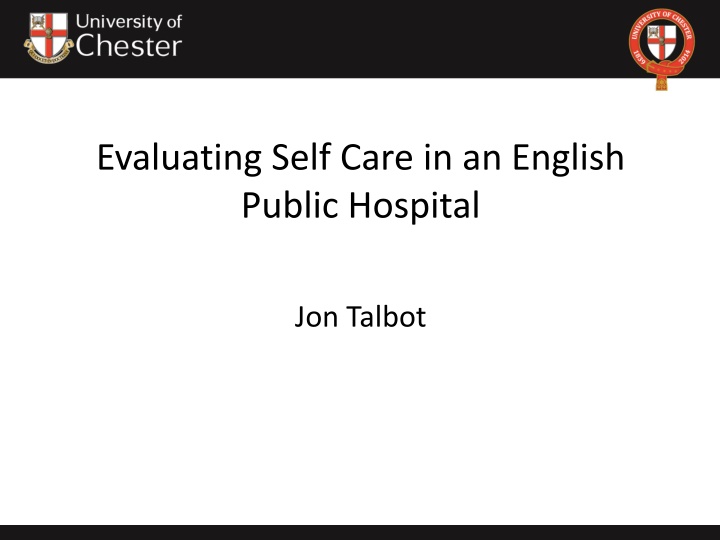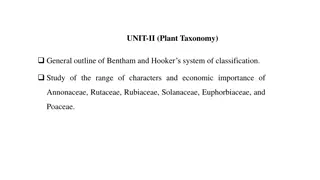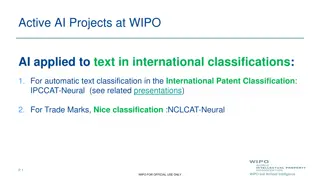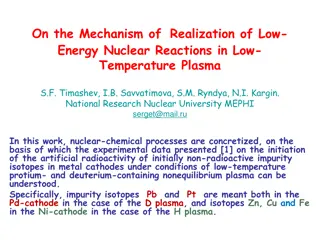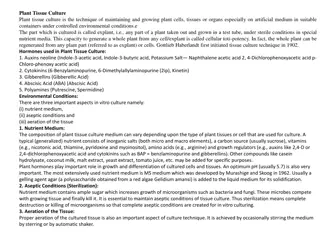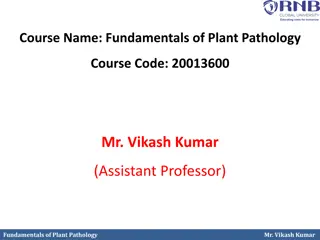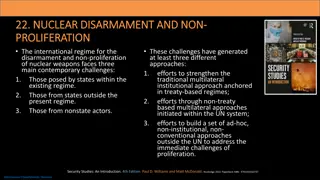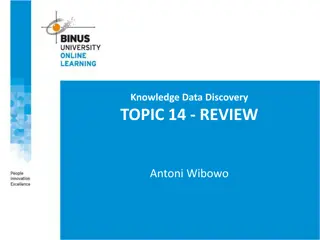Categorization and Classification of SSCs for a Nuclear Power Plant
This content explores the categorization and classification of Structures, Systems, and Components (SSCs) for a current generation nuclear power plant using the RIPB Advanced Reactor Standard. It delves into the motivation behind this evaluation, outlines the top-level criteria, and describes the classification and categorization results. ANSI/ANSI standards, licensing basis event identification, and risk-informed performance-based design are key aspects discussed.
Download Presentation

Please find below an Image/Link to download the presentation.
The content on the website is provided AS IS for your information and personal use only. It may not be sold, licensed, or shared on other websites without obtaining consent from the author.If you encounter any issues during the download, it is possible that the publisher has removed the file from their server.
You are allowed to download the files provided on this website for personal or commercial use, subject to the condition that they are used lawfully. All files are the property of their respective owners.
The content on the website is provided AS IS for your information and personal use only. It may not be sold, licensed, or shared on other websites without obtaining consent from the author.
E N D
Presentation Transcript
Evaluating Self Care in an English Public Hospital Jon Talbot
Context Absenteeism because of sickness has been declining nationally and internationally for a number of years: the same pattern is apparent in the NHS but it remains significantly higher especially in hospitals (Boorman 2009) North West Hospital (NWH) also has declining rates but they are above regional and national averages. A series of initiatives have failed to solve the problem.
The Self Care Programme Developed in a West Midlands Hospital and claimed to significantly improve the sickness record of those with multiple incidence of short term sickness. Assumes sickness the result of personal ignorance of factors likely to promote wellness Two day programme, with three monthly follow ups
Self Care Programme at NW Hospital Introduced as a positive measure with full support of trade unions from 2012. Evaluation conducted late 2014 of first three cohorts (N=37)
Data requirements Introduced as a positive measure with full support of trade unions from 2012. Evaluation conducted late 2014 of first three cohorts (N=37). From these final cohort excluded as did not match criteria for having poor sickness record prior to attendance and a further two excluded since sickness records 12 months prior and post attendance at workshop missing. Final sample of 25.
Aims of the research Estimate the value to participating employees in terms of improved personal health and well being Estimate the effect of the programme in reducing absenteeism levels among participants over the short term as a means of enabling NWH to meet its 4% sickness target Calculate the total cost of the programme relation to total savings as a means of establishing VFM If appropriate identify potential modifications/ alternatives to identify the most effective and efficient means for NWH to achieve its 4% target.
NWH data requirements Time series data on sickness rates for NWH to include disaggregation as is available such as age, gender, reason for absence, grade and operational role-- in order to make comparisons and identify trends Data on SCP participants to include age, gender, role, grade, salary in order to create a profile of participants compared with the global NWH population and establish whether particular types of employee are most likely to benefit from SCP, calculate potential salary savings and so on Sickness absence records (to include days lost and reasons for absence) for NWH participants pre and post attendance- in order to identify any observable changes All existing data collected from participants at SCP workshops to include immediate reactions to the workshop, the three month and six/twelve month reviews- in order to evaluate the impact of the programme upon participants health and well being Details of other sickness absence interventions over the relevant time period- in order to isolate the effect of SCP Estimated cost of programmes (trainers, materials, time away from the workplace) in order to compare with potential savings from reduced absenteeism.
External data requirements Aggregate sickness levels for the North West England and UK workforce over relevant time periods Aggregate sickness levels in the UK National Health Service nationally/ locally and in comparable Hospital as available All other published sources of information including published reports and research findings.
Table 1: Reasons for sickness absence (incidents) at NWH 2014 Reasons for sickness absence 2014 Cause No. Gastrointestinal problems 1523 Cough, colds, flu 924 Anxiety, stress, depression etc. 540 Musculoskeletal problems 417 Back problems 365 Ear nose and throat 355 Chest and respiratory problems 338 Injury, fracture 298 Headache, migraine 269 Genitourinary and gynaecological 258 Pregnancy related 233 All other causes (14 categories) 1034 Total 6554
SCP workshop attendees compared with NWH as a whole NWH Attendees Cohorts 1 & 2 Total (n) 5,500 25 Average age (n) 43 45 Females (%) 79.8 70.8 (1 gender record missing N=24) Males (%) 20.2 29.2 (1 gender record missing N=24) Staff nurses (%) 21 22 Healthcare assistants (%) 17 29
SCP workshop attendees evaluation of the workshop (N= 37) Excellent Activity Poor Limited benefit Average Very beneficial 16 1: Health and safety beliefs 5 15 17 2: Motivation and change 2 17 18 3: Self-care, esteem, confidence 4. Stress and coping 2 16 15 21 16 5: Healthy eating 8 12 13 6: Physical wellbeing 5 18 22 Quality of provision 2 12 28 Overall assessment 7 Would recommend to others 34 (92%)
Number of days absent sick 12 months prior to attending SCP Workshop and 12 months post attendance (N=25 ) Days absent sick 12 months pre-workshop 2021 Days absent sick 12 months post-workshop 1119 % change -45% Episodes of sickness 12 months pre-workshop 66 Episodes of sickness 12 months post-workshop 38 % change -42%
Attendance at Post Workshop Review, Pre- and Post-12 months days lost for sickness (N=25) Total number Pre-workshop days sickness (12 months) Post- workshop days sickness (12 months) 1119 % change Attended workshop 25 2021 -45% Attended 3 month review 9 1066 271 -75% Attended 6 month review 7 776 159 -80% Attended no reviews 11 617 751 +22%
Number of days absent sick 12 months prior to being due to attend SCP Workshop but not attending and 12 months post attendance (N=11 ) Days absent sick 12 months prior to non-attendance 427 Days absent sick 12 months post non-attendance 217 % change -49% Episodes of sickness 12 months prior to non-attendance 42 Episodes of sickness 12 months post non-attendance 31 % change -26%
Reasons for episodes of absence 12 months pre-workshop compared with 12 months post-workshop (N=25) Reason Pre- Post % change programme episodes programme episodes Gastrointestinal problems 10 12 +20% Musculoskeletal problems 12 4 -67% Anxiety, stress, depression etc. 7 6 -14% Colds, Coughs, Flu 7 2 -71% Chest and respiratory 6 2 -67% Genitourinary and gynaecological 6 0 -100% Headache, migraine 2 0 -100% All other causes (9 categories and 1 record missing) 16 12 -25% Total 66 38 -42%
Estimated total salary cost to NWH of Workshops (Cohorts 1 and 2 only) (N=25) Attending employees Working days attendance Average daily salary cost ( ) + 12.5% Agency Bank fee ( ) Total cost of attendance ( ) Clinical staff 38.4 83.47 93.90 3,605.90 Non clinical staff 18 76.04 NA 1,368.72 Total 56.4 4,974.62
Potential cost savings to NWH from improved attendance for participants in the 12 months post SCP workshop attendance (N=25) Attending employees Days saved Average daily salary ( ) +12.5% Agency Bank fee ( ) Total estimated salary savings ( ) Clinical staff 590 83.47 93.90 55,403.21 Non clinical staff 312 76.04 NA 23,724.48 Total 902 79,127.69
Conclusions Very small study but interesting findings. Difficult to say whether SCP has much real effect at all: if it does it is probably very limited. Other mechanisms may be more effective- such as regular interviews, strategies to reduce gastrointestinal sickness (ie viral), addressing workplace stress. Some hospitals have consistently lower sickness rates than others: lessons to be learned?
